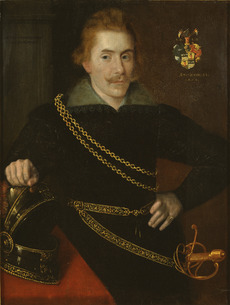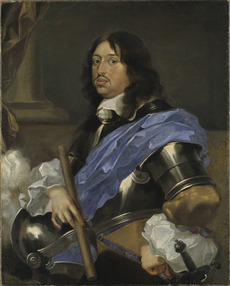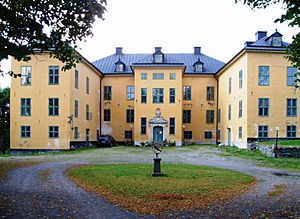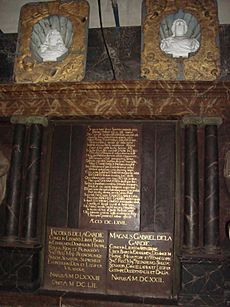Magnus Gabriel De la Gardie facts for kids
Quick facts for kids
Count
Magnus Gabriel De la Gardie
|
|
|---|---|

Portrait by Hendrik Munnichhoven
|
|
| Lord High Treasurer of Sweden | |
| In office 1652–1660 |
|
| Preceded by | Gabriel Bengtsson Oxenstierna |
| Succeeded by | Gustaf Bonde |
| Lord High Chancellor of Sweden | |
| In office 1660–1680 |
|
| Preceded by | Erik Oxenstierna |
| Succeeded by | None – office abolished (until 1792) |
| Lord High Steward of Sweden | |
| In office 1680–1684 |
|
| Preceded by | Per Brahe the Younger |
| Succeeded by | None – office abolished (until 1787) |
| Governor-General of Livonia | |
| In office 1649–1651 |
|
| Preceded by | Gabriel Bengtsson Oxenstierna |
| Succeeded by | Gustav Horn |
| In office 1655–1657 |
|
| Preceded by | Gustav Horn |
| Succeeded by | Axel Lillie (in 1661) |
| Personal details | |
| Born | 15 October 1622 Reval, Swedish Estonia |
| Died | 26 April 1686 (aged 63) Venngarn Castle, Sigtuna, Sweden |
| Spouse | Maria Euphrosyne of Zweibrücken |
| Children | Gustaf Adolf De la Gardie, Catharina Charlotta De la Gardie, Hedvig Ebba De la Gardie |
| Residences | Makalös Palace, Stockholm Venngarn Castle Läckö Castle |
Count Magnus Gabriel De la Gardie (born October 15, 1622 – died April 26, 1686) was an important Swedish leader and military man. He joined the Swedish Privy Council in 1647. This was a group of advisors to the king. He held three of the five most powerful jobs in the country. These were Lord High Treasurer, Lord High Chancellor, and Lord High Steward. He also served as Governor-General in Livonia, which was a Swedish territory.
Contents
Magnus Gabriel De la Gardie's Life Story
Early Life and Family Background
Magnus Gabriel De la Gardie was born on October 15, 1622, in Reval (today called Tallinn), Estonia. At that time, Estonia was part of Sweden. His father, Jacob De la Gardie, was serving there as a governor. Jacob De la Gardie, who was the Count of Läckö, was a famous military leader. He was the Lord High Constable of Sweden from 1620 until he died in 1652.
Magnus Gabriel's grandfather, Pontus De la Gardie, was a French soldier. He first worked for Denmark but later joined Sweden. Pontus married Sofia Gyllenhielm, who was the daughter of King John III, in 1580.
Magnus Gabriel's mother was Ebba Brahe. Her father was Magnus Brahe, the Lord High Steward. Ebba Brahe was close to the young King Gustavus Adolphus. He wanted to marry her around 1613–1615. However, the king's mother, Christina of Holstein-Gottorp, did not approve. So, in 1618, Ebba Brahe married Jacob De la Gardie instead.
Ebba and Jacob had 14 children together. Seven of them lived to be adults. These were Magnus Gabriel, Maria Sofia, Jacob Casimir, Pontus Frederick, Christina Catharina, Axel Julius, and Ebba Margaretha.
Magnus Gabriel's Important Career
Starting His Public Service
Magnus Gabriel came from a very rich and respected family. This meant he was expected to have a great career. He received an excellent education from his teacher, Mattias Björnklou. In 1639, he was chosen as rector illustris at Uppsala University. This special position allowed a student to help oversee the university. It was hoped he could use his family connections to help the university financially.
The next year, he traveled to France and the Netherlands to continue his studies. When the Torstenson War between Sweden and Denmark began in 1643, he returned home. He learned about warfare under the command of Field Marshal Gustav Horn.
Serving Under Queen Christina (1644–1654)
When Queen Christina became queen (1644–1654), Magnus Gabriel quickly became very close to her. He was only 23 years old. People said he was well-mannered and good-looking. His knowledge of culture, politics, and how to present himself also impressed the queen. He was also good at organizing big parties and showing off wealth. These skills were important at a time when powerful people were expected to be smart, strong, and also grand.
In 1645, he became a colonel in the Life Guards. In 1646, he led a special trip to France. His goal was to find musicians for Queen Christina's court in Sweden. This trip was a big success for him. When he returned, he received many honors. The queen also arranged his wedding to her cousin, Maria Eufrosyne of Zweibrücken, at the Royal Palace. After the wedding, he became a Privy Councillor.
On April 17, 1648, he was promoted to general. He served under the future king, Charles Gustav, who was also his brother-in-law. This was during the Siege of Prague, which happened at the end of the Thirty Years' War. Even though he didn't do much in the war, he received a large reward of money. That same year, he became the count of Arensburg (Kuressaare). In 1649, he started his first time as Governor-General of Livonia.
Before Queen Christina's coronation, Magnus Gabriel gave her a beautiful silver throne. It was used for the event. At the coronation in 1650, he had the honor of carrying the royal banner. A year later, in 1651, he finished his first term in Livonia. He was then appointed Marshal of the Realm. In 1652, he became Lord High Treasurer. This was one of the five most important positions in the government. He was also the head of the Kammarkollegiet, which managed the country's finances. Also in 1652, he became a lawspeaker (a legal official) for Västergötland and Dalsland. When his father Jacob died that year, Magnus Gabriel inherited Läckö Castle and became the Count of Läckö.
Losing the Queen's Trust
In 1653, Magnus Gabriel lost the queen's trust. He and his family had to leave the court. For the rest of Queen Christina's rule, he lived on his country estates. However, Queen Christina soon gave up her throne. She was replaced by Charles Gustav, who was Magnus Gabriel's wife's brother.
Serving Under King Charles X Gustav (1654–1660)
When Charles Gustav became king, Magnus Gabriel returned to public life. In August 1654, he became governor of Västergötland, Dalsland, and Halland. In December that year, he became the chancellor of Uppsala University. In 1655, he was chosen for the second time to be Governor-General of Livonia. He also became a Lieutenant General for Swedish troops. This meant he commanded soldiers in the wars against Poland and Russia.
It seems Magnus Gabriel was not a very good military leader. The king often complained about his actions. During peace talks with Poland, Magnus Gabriel was Sweden's main representative. He helped with the discussions that led to the Treaty of Oliva in 1660.
King Charles X Gustav died in early 1660. According to his will, Magnus Gabriel was appointed Lord High Chancellor. This made him a member of the group that ruled Sweden while the young Charles XI was too young to be king (1660–1672). This group was called the regency.
Leading the Regency (1660–1672)
Magnus Gabriel was the most famous and powerful member of the regency. However, others often challenged him. This might have been because he often left the court to spend time at his many estates. This was not good for the government or for his own power.
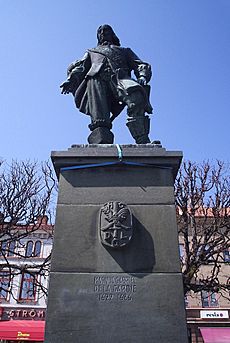
He was experienced and had many important connections. But he often looked to the past and old traditions from the Thirty Years' War. He did not have new ideas for the changing times. The regency was split into different groups. Magnus Gabriel led the group that wanted more wars and a close relationship with France. The other group, led by Lord High Treasurer Gustaf Bonde, wanted peace and to save money. Magnus Gabriel's ideas usually won. Because of this, Sweden almost went to war with Russia and Poland during this time.
In 1661, Sweden and France signed a treaty. It included a secret part where Sweden promised to support France's choice for the Polish king. In return, Sweden would get a lot of money. In April 1672, they signed another treaty in Stockholm. Sweden promised to keep an army in its German lands. This was to stop German states from interfering in a war between France and its enemies, the Netherlands and Spain. In return, Sweden would get money every year. This money was very important for Sweden, which had big financial problems. Magnus Gabriel believed this was a better way to get money than taking back lands given to nobles.
Magnus Gabriel himself was partly responsible for Sweden's money problems. He gave away some of the Crown's (the state's) money and resources to himself and for private matters. Meanwhile, the navy became weak because it didn't get enough money. Soldiers also left the army because they weren't paid.
Serving Under King Charles XI (1672–1686)
In December 1672, King Charles XI became old enough to rule. Many people thought Magnus Gabriel's power would decrease. But he actually became more powerful than ever. The young king was new to ruling and seemed happy to take advice from his Lord High Chancellor, Magnus Gabriel. Magnus Gabriel tried to increase the king's power, which he hoped would also increase his own.
However, after 1675, his influence started to decrease. That year, Sweden joined the Franco-Dutch War because of its treaty with France. Sweden invaded Brandenburg. Even though Sweden had more soldiers, they lost at Fehrbellin. This encouraged Denmark to attack Sweden, starting the Scanian War. Around the time of King Charles's coronation that same year, Magnus Gabriel was accused of serious wrongdoing. But this accusation was soon found to be false.
During the Scanian War, Magnus Gabriel led troops against the Norwegian army. Like his earlier military actions, this one was not successful. He suffered a big defeat at Uddevalla in 1677.
Losing Power and Wealth
The difficult times in the late 1670s, mainly due to the war, were linked to the treaty with France. Magnus Gabriel had strongly supported this treaty. These hard times led to big changes in 1680. Sweden's financial crisis made King Charles XI call a meeting of the Riksdag of the Estates in October 1680.
Here, the king finally pushed through a plan called the reduction. This meant that any land or property previously owned by the Crown and given away could be taken back. This included counties and lordships. This decision greatly weakened the power of the Swedish nobles.
Another important decision was about the Privy Council. Since 1634, the king had to take advice from this council. But during the Scanian War, the council members argued among themselves. The king mostly ruled without listening to them. At the 1680 meeting, he asked if he still had to follow the council's advice. The estates told him he was "not bound by anyone other than himself." This officially made Sweden an absolute monarchy, where the king had all the power. Magnus Gabriel had tried to get the Privy Council members to resist this change, but he failed.
Before this meeting, Magnus Gabriel had been removed from his job as Lord High Chancellor. He was instead made Lord High Steward. This meant he lost a lot of his general influence, especially over Sweden's foreign policy.
Perhaps no one was affected more negatively by the reduction than Magnus Gabriel. He was judged to owe the state a huge amount of money. He lost almost all his wealth because the Crown took back his properties. For example, his Läckö estate was taken back very quickly. The only estates he could keep were Venngarn and Höjentorp.
In 1675, a special group was formed to look into what Magnus Gabriel and other high-ranking nobles had done. On May 27, 1682, this group decided that the regents and the council were responsible for mismanaging the country's money. Magnus Gabriel was treated somewhat kindly. He was "given permission to retire to his estates for the rest of his life." He spent his final days at Venngarn. He couldn't understand what he had done wrong. He sadly said, "What I have gained in 38 years, and my father and ancestors in 40 years, is gone." Magnus Gabriel De la Gardie died at Venngarn on April 26, 1686.
Magnus Gabriel had helped create the treaty with France. He had also worked hard to increase the young King Charles's power. It's ironic that the treaty helped push Sweden into a deep financial crisis. This crisis, along with the king's new power, led to the reduction. So, Magnus Gabriel's own actions played a big part in his fall from power and wealth.
Magnus Gabriel's Personal Life
Wife and Children
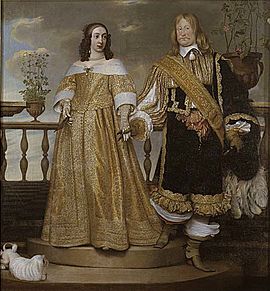
On March 7, 1647, Magnus Gabriel married Maria Eufrosyne of Zweibrücken. The wedding took place in the chapel at the Royal Palace Tre Kronor. Maria Eufrosyne was Queen Christina's cousin and the sister of the future King Charles X Gustav. She was described as a "poor princess" who greatly benefited from marrying "the richest of the Swedish magnates." Queen Christina helped arrange the marriage.
The marriage of Magnus Gabriel and Maria Eufrosyne is said to have been a happy one. Maria Eufrosyne gave birth to eleven children. Only three of them lived longer than their parents. These three were Privy Councillor Gustaf Adolf (1647–95), Catharina Charlotta (1655–97, who married Field Marshal Otto Wilhelm Königsmarck), and Hedvig Ebba (around 1659 – 1700, who married Count Carl Gustaf Eriksson Oxenstierna).
Property Owner and Builder
During his life, Magnus Gabriel managed to get many estates and castles. At his most powerful, he owned properties in several Swedish provinces. These included Karlberg, Drottningholm, Jakobsdal (now Ulriksdal), Venngarn, Ekholmen, Kägleholm, Läckö, Traneberg, Mariedal, Katrineberg, and Höjentorp. He also owned large properties in Livonia, Finland, Pomerania, and Mecklenburg, which were all part of Sweden at the time.
Every nobleman needed a good home in the capital city, Stockholm. Magnus Gabriel's father, Jacob, built a grand palace near the royal palace. It was called the De la Gardie Palace, or Makalös Palace. When Jacob died in 1652, Magnus Gabriel inherited it. This palace was the most impressive private home in Stockholm. It had more magnificent belongings than even the royal palace.
Magnus Gabriel was known for being a very active builder. He had many building projects going on at once. In 1674, an Italian diplomat estimated that Magnus Gabriel had at least 50 ongoing projects in Sweden and its territories. This did not include the 37 churches he was building or repairing at the time. One of the churches he restored was the abbey church of Varnhem. He created a family mausoleum there. Magnus Gabriel himself, his wife Maria Eufrosyne, their son Gustav Adolf, and their daughter-in-law Elisabet Oxenstierna are buried there.
At Läckö, Magnus Gabriel ordered big additions, starting in 1654. For example, a fourth floor was added to the main tower, and a castle chapel was built. The number of staff at the castle grew from 83 to 222 between 1662 and 1678. This shows how nobles' estates were becoming like their own small societies at that time.
Contributions to Culture and Arts
Magnus Gabriel De la Gardie is seen as one of the biggest supporters of science and art in Swedish history. He brought architects, sculptors, and painters to Sweden. They helped with his building and restoration projects. Jean de la Vallée and Nicodemus Tessin the Elder were among the architects he hired.
In 1666, Magnus Gabriel made sure Sweden had an organized way to protect its historical treasures. This was the first of its kind in Europe.
The "Silver Bible"
The Codex Argenteus, also known as the "Silver Bible," is a very old book from the 6th century. It was brought to Sweden as war loot from Prague at the end of the Thirty Years' War in 1648. Isaac Vossius, a Dutch librarian for Queen Christina, took it to his hometown. In 1662, Magnus Gabriel bought the book. In 1669, he gave it to the university after having it bound in a beautiful silver cover.
The Silver Throne
A silver throne given by Magnus Gabriel De la Gardie is a central piece in Rikssalen (the Hall of State) in Stockholm Palace. The throne was a gift from Magnus Gabriel to Queen Christina for her coronation in 1650. Magnus Gabriel hired Abraham Drentwett from Augsburg to create it.
|


